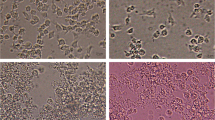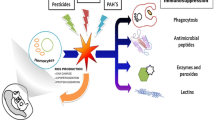Abstract
This study assessed the responses of primary cultured haemocytes from the marine gastropod Haliotis tuberculata exposed to the increasing concentrations of industrial effluent (0, 0.5, 1, 10, 15 and 20%) discharged into the Tunisian coastal area. Analyses showed the presence of metals such as cadmium (Cd), chromium (Cr), copper (Cu), manganese (Mn), zinc (Zn), nickel (Ni) and lead (Pb) in the effluent. The effects of this mixture of pollutants on abalone haemocyte parameters were reflected by a significant decrease of cell viability, phagocytotic activity and reactive oxygen species (ROS) production as well as morphological and lysosomal membrane alterations. Thus, these results indicated that our primary culture system represents a suitable in vitro model for monitoring of anthropogenic contaminants in aquatic environments.





Similar content being viewed by others
References
Adema CM, Vanderknaap WPW, Sminia T (1991) Molluscan hemocyte-mediated cytotoxicity: the role of reactive oxygen intermediates. Rev Aquat Sci 4:201–223
Akaishi FM, St-Jean SD, Bishay F, Clarke J, Rabitto IdS, Ribeiro CAdO (2007) Immunological responses, histopathological finding and disease resistance of blue mussel (Mytilus edulis) exposed to treated and untreated municipal wastewater. Aquat Toxicol 82:1–14
Allison AC, Young MR (1964) Uptake of dyes and drugs by living cells in culture. Life Sci 3:1407
Auffret M, Rousseau S, Boutet I, Tanguy A, Baron J, Moraga D, Duchemin M (2006) A multiparametric approach for monitoring immunotoxic responses in mussels from contaminated sites in western Mediterranean. Ectotoxicol Environ Saf 63:393–405
Bachère E, Chargot D, Grizel H (1988) Separation of Crassostrea gigas hemocytes by density gradient centrifugation and counter flow centrifugal elutriation. Dev Comp Immunol 12:549–559
Bass DA, Parce JW, Dechatelet LR, Szejda P, Seeds MC, Thomas M (1983) Flow cytometry studies of oxidative product formation by neutrophils: a graded response to membrane stimulation. J Immunol 130:1910–1917
Butler R, Roesijadi G (2000) Metallothionein (MT) gene expression and cadmium-induced immunotoxicity in haemocytes of the eastern oyster Crassostrea virginica. Mar Environ Res 50:465–472
Chakraborty S, Ray S (2009) Nuclear morphology and lysosomal stability of molluscan hemocytes as possible biomarkers of arsenic toxicity. Clean 37:769–775
Chora S, Starita-Geribaldi M, Guigonis JM, Samson M, Roméo M, Bebianno MJ (2009) Effect of cadmium in the clam Ruditapes decussatus assessed by proteomic analysis. Aquat Toxicol 94:300–308
Coles JA, Farley SR, Pipe RK (1995) Alteration of the immune response of the common marine mussel, Mytilus edulis resulting from exposure to cadmium. Dis Aquat Organ 30:367–379
Cong M, Wu H, Liu X, Zhao J, Wang X, Lv J, Hou L (2012) Effects of heavy metals on the expression of a zinc-inducible metallothionein-III gene and antioxidant enzyme activities in Crassostrea gigas. Ecotoxicology 21:1928–1936
Coteur G, Danis B, Dubois P (2005) Echinoderm reactive oxygen species (ROS) production measured by peroxidase, luminol-enhanced chemiluminescence (PLCL) as an immunotoxicological tool. Prog Mol Subcell Biol 39:71–83
De Duve C, de Barsy T, Poole B, Trouet A, Tulkens P, Van Hoof F (1974) Commentary. Lysosomotropic agents. Biochem Pharmacol 23:2495–2531
Domart-Coulon I, Auzoux-Bordenave S, Doumenc D, Khalanski M (2000) Cytotoxicity assessment of antibiofouling compounds and by-products in marine bivalve cell cultures. Toxicol In Vitro 14:245–251
Donaghy L, Kraffe E, Le Goïc N, Lambert C, Volety AK, Soudant P (2012) Reactive oxygen species in unstimulated hemocytes of the Pacific oyster Crassostrea gigas: a mitochondrial involvement. PLoS ONE 7:e46594
Dyrynda EA, Pipe RK, Burt GR, Ratcliffe NA (1998) Modulations in the immune defenses of mussels (Mytilus edulis) from contaminated sites in the UK. Aquat Toxicol 42:169–185
Farcy E, Gagné F, Martel L, Fortier M, Trépanier S, Brousseau P, Fournier M (2011) Short-term physiological effects of a xenobiotic mixture on the freshwater mussel Elliptio complanata exposed to municipal effluents. Environ Res 111:1096–1106
Gagne F, Andre C, Cejka P, Hausler R, Fournier M, Blaise C (2008) Immunotoxic effects on freshwater mussels of a primary-treated wastewater before and after ozonation: a pilot plant study. Ecotoxicol Environ Saf 69:366–373
Gaume B, Bourgougnon N, Auzoux-Bordenave Roig B, Le bot B, Bedoux G (2012) In vitro effects of triclosan and methyl-triclosan on the marine gastropod Haliotis tuberculata. Comp Biochem Physiol 156:87–94
Gomez-Mendikute A, Cajaraville MP (2003) Comparative effects of cadmium, copper, paraquat and benzo[a]pyrene on the actin cytoskeleton and production of reactive oxygen species (ROS) in mussel haemocytes. Toxicol In Vitro 17:539–546
Gopalakrishnan S, Thilagam H, Huang WB, Wang KJ (2009) Immunomodulation in the marine gastropod Haliotis diversicolor exposed to benzo(a)pyrene. Chemosphere 75:389–397
Gorski J, Nugegoda D (2006) Sublethal toxicity of trace metals to larvae of the blacklip abalone, Haliotis rubra. Environ Toxicol Chem 25:1360–1367
Hégaret H, Wikfors GH, Soudant P (2003) Flow cytometric analysis of haemocytes from eastern oysters, Crassostrea virginica, subjected to a sudden temperature elevation. II. Haemocyte functions: aggregation, viability, phagocytosis, and respiratory burst. J Exp Mar Biol Ecol 293:249–265
Heys KA, Shore RF, Pereira MG, Jonesa KC, Martin FL (2016) Risk assessment of environmental mixture effects. RSC Adv 6:47844–47857
Kamel N, Jebali J, Banni M, Ben Khedher S, Chouba L, Boussetta H (2012) Biochemical responses and metals levels in Ruditapes decussatus after exposure to treated municipal effluents. Ecotoxicol Environ Saf 82:40–46
Katsumiti A, Gilliland D, Arostegui I, Cajaraville MP (2014) Cytotoxicity and cellular mechanisms involved in the toxicity of CdS quantum dots in hemocytes and gill cells of the mussel Mytilus galloprovincialis. Aquat Toxicol 53:39–52
Ladhar-Chaabouni R, Machreki-Ajmi M, Hamza-Chaffai A (2012) Use of metallothioneins as biomarkers for environmental quality assessment in the Gulf of Gabès (Tunisia). Environ Monit Assess 184:2177–2192
Ladhar-Chaabouni R, Machreki-Ajmi M, Serpentini A, Lebel JM, Hamza-Chaffai A (2014) Does a short term exposure to cadmium chloride affects haemocyte parameters of the marine gastropod Haliotis tuberculata?. DOI, Environ Sci Pollut Res. doi:10.1007/s11356-014-3387-5
Lambert C, Soudant P, Choquet G, Paillard C (2003) Measurement of Crassostrea gigas hemocyte oxidative metabolism by flow cytometry and the inhibiting capacity of pathogenic vibrios. Fish Shellfish Immunol 15:225–240
Latire T, Le Pabic C, Mottin E, Mottier A, Costil K, Koueta N, Lebel JM, Serpentini A (2012) Responses of primary cultured haemocytes from the marine gastropod Haliotis tuberculata under 10-day exposure to cadmium chloride. Aquat Toxicol 109:213–221
Lebel JM, Giard W, Favrel P, Boucaud-Camou E (1996) Effects of different vertebrate growth factors on primary cultures of hemocytes from the gastropod mollusc, Haliotis tuberculata. Biol Cell 86:67–72
Lowe DM, Fossato VU (2000) The influence of environmental contaminants on lysosomal activity in the digestive cells of mussels (Mytilus galloprovincialis) from the Venice lagoon. Aquat Toxicol 48:75–85
Lowe DM, Pipe RK (1994) Contaminant induced lysosomal membrane damage in marine mussel digestive cells: an in vitro study. Aquat Toxicol 30:357–365
Lowe DM, Fossato VU, Depledge MH (1995) Contaminant-induced lysosomal membrane damage in blood cells of mussels Mytilus galloprovincialis from the Venice lagoon: an in vitro study. Mar Ecol Prog Ser 129:189–196
Marchi B, Burlando B, Moore MN, Viarengo A (2004) Mercury- and copper induced lysosomal membrane destabilisation depends on [Ca2 +]i dependent phospholipase A2 activation. Aquat Toxicol 66:197–204
Marigomez JA, Cajaraville MP, Angulo E (1990) Cellular cadmium distribution in the common winkle, Littorina littorea (L.) determined by X-ray microprobe analysis and histochemistry. Histochemistry 94:191–199
Matozzo V, Ballarin L, Pampanin DM, Marin MG (2001) Effects of copper and cadmium exposure on functional responses of hemocytes in the clam, Tapes philippinarum. Arch Environ Contam Toxicol 41:163–170
McIntosh LM, Robinson WE (1999) Cadmium turnover in the hemocytes of Mercenaria mercenaria (L.) in relation to hemocyte turnover. Comp Biochem Physiol C 123:61–66
Moore MN, Lowe DM, Fieth PEM (1994) Lysosomal responses to experimentally injected anthracene in the digestive cells of Mytilus edulis. Mar Biol 48:297–302
Moore MN, Allen JI, McVeigh A (2006) Environmental prognostics: an integrated model supporting lysosomal stress responses as predictive biomarkers of animal health status. Mar Environ Res 61:278–304
Mosmann T (1983) Rapid colorimetric assay for cellular growth and survival: application to proliferation and cytotoxicity assays. J Immunol Methods 65:55–63
Mottin E, Caplat C, Mahaut ML, Costil K, Barillier D, Lebel JM, Serpentini A (2010) Effect of in vitro exposure to zinc on immunological parameters of haemocytes from the marine gastropod Haliotis tuberculata. Fish Shellfish Immunol 29:846–853
Mount AS, Wheeler AP, Paradkar RP, Snider D (2004) Hemocyte-mediated shell mineralization in the eastern oyster. Science 304:297–300
Nzengue Y, Steiman R, Garrel C, Lefèvre E, Guiraud P (2008) Oxidative stress and DNA damage induced by cadmium in the human keratinocyte HaCat cell line: role of glutathione in the resistance to cadmium. Toxicology 243:193–206
Olabarrieta I, L’Azou B, Yuric S, Cambar J, Cajaraville MP (2001) In vitro effects of cadmium on two different animal cell models. Toxicol In Vitro 15:511–517
Salo HM, Hebert N, Dautremepuits C, Cejka P, Cyr DG, Fournier M (2007) Effects of Montreal municipal sewage effluents on immune responses of juvenile female rainbow trout (Oncorhynchus mykiss). Aquat Toxicol 84:406–414
Sauvé S, Hendawi M, Brousseau P, Fournier M (2002a) Phagocytic response of terrestrial and aquatic invertebrates following in vitro exposure to trace elements. Ecotoxicol Environ Saf 52:21–29
Sauvé S, Brousseau P, Pellerin J, Morin Y, Senécal L, Goudreau P, Fournier M (2002b) Phagocytic activity of marine and freshwater bivalves: in vitro exposure of hemocytes to metals (Ag, Cd, Hg and Zn). Aquat Toxicol 58:189–200
Schirmer K (2006) Proposal to improve vertebrate cell cultures to establish them as substitutes for the regulatory testing of chemicals and effluents using fish. Toxicology 224:163–183
Serpentini A, Ghayor C, Hebert V, Galéra P, Pujol JP, Boucaud-Camou E, Lebel JM (2000) De novo synthesis and identification of collagen transcripts in hemocytes from the gastropod mollusc, Haliotis tuberculata. J Exp Zool 287:275–284
Shuilleabhain SN, Mothershill C, Sheehan D, O’Brien NM, O’Halloran J, van Pelt F, Kilemade M, Davoren M (2006) Cellular responses in primary epidermal cultures from rainbow trout exposed to zinc chloride. Ecotoxicol Environ Saf 65:332–341
Soto M, Cajaraville MP, Marigomez I (1996) Tissue and cell distribution of copper, zinc and cadmium in the mussel, Mytilus galloprovincialis, determined by autometallography. Tissue Cell 28:557–568
Thiagarajan R, Gopalakrishnan S, Thilagam H (2006) Immunomodulation in the marine green mussel Perna viridis exposed to sub-lethal concentrations of Cu and Hg. Arch Environ Contam Toxicol 51:393–399
Zhu X, Zhou J, Cai Z (2011) The toxicity and oxidative stress of TiO2, nanoparticles in marine abalone (Haliotis diversicolor supertexta). Mar Pollut Bull 63:334–338
Acknowledgements
This work was supported by a grant from the Ministry of higher education and scientific research, University of Sfax, Tunisia to R. Ladhar-Chaabouni. The authors thank L. Poulain and M. Duval (Plateau Technique de Cytométrieen Flux,Université de Caen Normandie, France) for their helpful technical assistance, the technical staff of the Centre de Recherche en Environnement Côtier (Luc-sur-Mer, Normandie, France) for their assistance in animal care and F. Sdirat for English revision.
Author information
Authors and Affiliations
Corresponding author
Rights and permissions
About this article
Cite this article
Ladhar-Chaabouni, R., Houel, T., Serpentini, A. et al. Responses of primary cultured haemocytes derived from the marine gastropod Haliotis tuberculata to an industrial effluent exposure. Cytotechnology 69, 191–200 (2017). https://doi.org/10.1007/s10616-016-0050-7
Received:
Accepted:
Published:
Issue Date:
DOI: https://doi.org/10.1007/s10616-016-0050-7




